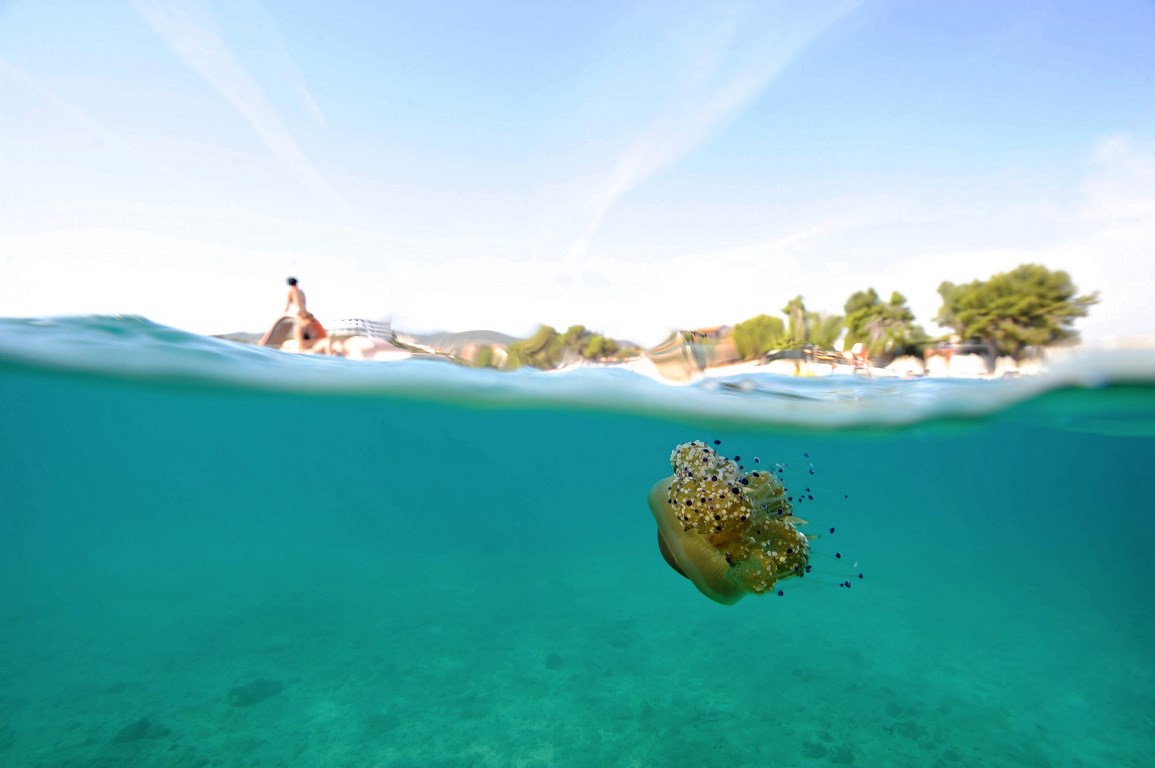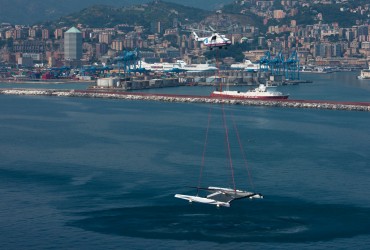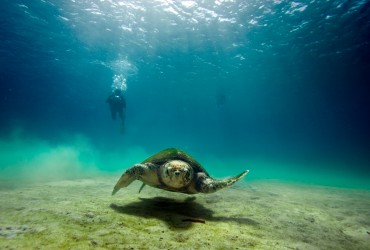Fishing for jellies
Somewhere off the coast of the Côte d’Azur in France, a sailing boat slices through the surface of the Mediterranean Sea. Nothing out of the ordinary, except that it’s pitch black in the middle of the night. The absence of moon light is the reason the crew chose this specific date. There is a small breeze, yet the engine is lazily humming. The sailing boat is heading straight offshore, leaving the blinding lights of Nice, Cannes and Monaco behind.
On board, the captain keeps an eye on the GPS while the other passengers are all busy. It’s not a leisurely cruise. On the starboard side, a bright torch is pointing downwards, strongly fixed to a horizontal mast about two meters above the surface. Since dusk, it has been illuminating a well-defined patch of water. A tiny confetti of color, drowned in a sea of total obscurity.
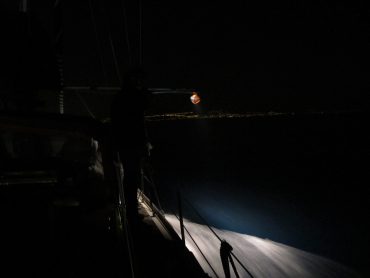 Fully absorbed and hypnotized by this small patch of light, a man is standing with a hand-held tally counter, clicking away every few seconds. He is safely attached to the boat with a harness. Here and there, strange forms appear for a fraction of a second through the beam of light. Suddenly, the clicking intensifies. On board, heads turn around. Apparently, they found what they were looking for.
Fully absorbed and hypnotized by this small patch of light, a man is standing with a hand-held tally counter, clicking away every few seconds. He is safely attached to the boat with a harness. Here and there, strange forms appear for a fraction of a second through the beam of light. Suddenly, the clicking intensifies. On board, heads turn around. Apparently, they found what they were looking for.
############
36 hours earlier, in one of the high-ceilings rooms of the Galériens building belonging to the Oceanological Observatory of Villefranche-sur-Mer, a phone is ringing. The premise’s occupant storms in, his hands still wet with water that has been artificially altered in order to measure the impacts on various marine organisms.
On his desk, the computer barely sticks out of the mass of files and various papers. On the walls, shelves threaten to give way under the weight of large scientific books and folders. There are also a few kid’s drawings, next to stuffed jellyfishes. The room is flooded in natural light coming from a tall window, looking directly on the bay of Villefranche. The Mediterranean Sea is so close to the old building, that it seems possible to stretch an arm out to collect samples.
The phone keeps ringing, and after drying his hands, the man ends up finding the handset under a file. He answers:
– Yes, Fabien speaking.
– Ah Fabien, it’s Alain on the phone. It took you some time. You were in the lab?
– Yes, I was checking some of my students’ work.
– I was calling to let you know, the weather forecast looks perfect for tomorrow evening. There won’t be any moon, and very light swells. If it’s okay with you, we can meet on the docks at 7 pm with all the gear ready?
– Fantastic! Let me call the rest of the crew to give them the news. See you tomorrow.
At 7 pm sharp the next day, Fabien Lombard, researcher at the Oceanological Observatory in Villefranche-sur-Mer and plankton expert, meets up with Alain Garcia and Chantal Dumas, the owners and captains of Alchimie, a 35-foot sailing yacht recently upgraded to welcome scientific missions. Tonight’s objective is to go out and hand count populations of jellyfish until 5 o’clock the next morning. It’s going to be a long night.
“You probably need to be a little bonkers to go and count jellyfish”, Fabien Lombard admits with a grin. “Yet, somebody has to do it. While a lot of people are arguing to know if jellyfish are more abundant than before, nobody actually goes out there to check. We tried to develop an autonomous underwater camera, but the results didn’t meet our expectations. It’s true that our technique is far less sexy, but we are able to count between 2’000 and 50’000 medusae during each of our nocturnal expeditions.”
A unique protocol was set up to standardize these missions. The objective is to sample the presence of a specific species of jellyfish in the waters off the coast of the Côte d’Azur over several years. “Every species of jellyfish is interesting, Fabien Lombard tells me, but we focus on the Pelagia noctiluca because it’s the most abundant medusa in this part of the Mediterranean and it’s the one responsible for the majority of stinging on our beaches. We now have precise counting sheets. We can then use the size and weight of sampled specimens to extrapolate quantities expressed in tons per square kilometer.”
 How does one find jellyfish colonies in the vastness of the sea? Wouldn’t it be easier to spot them during the day? Fabien Lombard answers: “As its name suggests, it’s a pelagic (Pelagia) jellyfish that can only be observed at night (nocti), when it swims back up from the depths. It was puzzling at first, but we gradually learned how and where to look for them. We now know that they are present all year round in the Mediterranean Sea, but not everywhere.”
How does one find jellyfish colonies in the vastness of the sea? Wouldn’t it be easier to spot them during the day? Fabien Lombard answers: “As its name suggests, it’s a pelagic (Pelagia) jellyfish that can only be observed at night (nocti), when it swims back up from the depths. It was puzzling at first, but we gradually learned how and where to look for them. We now know that they are present all year round in the Mediterranean Sea, but not everywhere.”

One of the specifics of the Mediterranean is its counterclockwise rotating marine currents. Which is the opposite of the clockwise rotating gyres in all of the oceans of the Northern Hemisphere, dictated by the Coriolis force. “In the oceans, Fabien Lombard adds, we tend to find jellyfish where the plastics congregates, in the gyre’s center. That’s where any floating object gets trapped by the circular movement of the great oceanic currents. In the Mediterranean, it’s quite the contrary. The plastic and the plankton will accumulate on the edge of the main currents.” In the western Mediterranean basin, it’s the Ligurian current that stirs and channels the planktonic system, which are all the living organisms unable to escape its flow.
Amongst the dead leaves, driftwood and now inescapable fragments of plastic, an important portion of the aquatic life can be found: the essential foundation for the entire marine food chain. The cycle of life starts with the phytoplankton, tiny photosynthesizing organisms. During the winter months, frequent storms stir the sea with such force that they are dispersed in all of the water column. During the calmer months of spring, they surface back up and take advantage of the lengthening days to create organic matter through photosynthesis. Their proliferation is what sustains the zooplankton, the animal part of the plankton. As these organisms grow and reproduce, they attract hungry pelagic predators that swim in the sea, and so on.
Teeming with microscopic life, the Ligurian current is the Pelagia noctiluca’s kingdom. Trapped in the eternal flow, this jellyfish only swims vertically, from the depths to the surface and back. “During nighttime, says Fabien Lombard, they come up to feed on the zooplankton while avoiding their predators. But when the moon is full, there is enough light to deter them to reach the surface. They rather stay several dozen meters deep. We know there are right there, all year round, but we are incapable of seeing and counting them. It’s the same when the swell reaches a certain height. They don’t enjoy being shaken around by the waves, so they stay in the security of the depths.” Therefore, the only way to see and count them is to sail out when the sea is particularly calm and the sky moonless. Suffice to say that occasions are rare.
 Villefranche-sur-Mer offers nonetheless an ideal base camp to launch these missions. The bay acts as a natural port, and the seafloor drops to a thousand meters deep or more after only a few miles. This allows scientists to reach high seas conditions without having to sail for hours. Through the years, the Oceanological Observatory thus became one of France’s most important marine stations for the study of the Mediterranean Sea. It is today part of the Pierre and Marie Curie University, and many students attend classes given by distinguished professors.
Villefranche-sur-Mer offers nonetheless an ideal base camp to launch these missions. The bay acts as a natural port, and the seafloor drops to a thousand meters deep or more after only a few miles. This allows scientists to reach high seas conditions without having to sail for hours. Through the years, the Oceanological Observatory thus became one of France’s most important marine stations for the study of the Mediterranean Sea. It is today part of the Pierre and Marie Curie University, and many students attend classes given by distinguished professors.
The Ligurian current also takes advantage of the seafloor’s extreme depth to flow dangerously close to the Côte d’Azur. Sometimes, it follows the coast less than 30 nautical miles (around 55 kilometers) offshore. This advantage for the scientists can turn into a calamity for the hordes of beach enthusiasts. Fabien Lombard explains: “During our nocturnal expeditions to count jellyfish, we aim to reach the edge of the Ligurian current, where most of the plankton is concentrated. We start counting as soon as we set sail, and there is suddenly a moment when the population of jellyfish on the surface explodes. In some cases, we can see between two and five jellyfishes per square meter. Then, each click represents 100 individuals. It’s easy to imagine that with a small oscillation of the current or a strong episode of onshore winds, all of this parade would be sent straight towards the beaches.”
 Every species of jellyfish is urticant to some extent, but many aren’t armed with cnidocytes powerful enough to pierce the skin of a man. These tiny explosive cells equipped with a harpoon filled with venom are used to neutralise their preys. The Pelagia noctiluca has her fair share of these powerful weapons. Around its mouth, long tentacles and arms covered in cnidocytes are deployed. “The Pelagia delivers a cocktail of venom, says Fabien Lombard. First, there is the neurotoxic venom that stings and tries to paralyze the victim. Upon contact, you feel like you touched an oven’s scorching hot door. Then, there is the proteolytic venom, whose mission is to begin the process of digestion. This is the responsible for the long-lasting scar.”
Every species of jellyfish is urticant to some extent, but many aren’t armed with cnidocytes powerful enough to pierce the skin of a man. These tiny explosive cells equipped with a harpoon filled with venom are used to neutralise their preys. The Pelagia noctiluca has her fair share of these powerful weapons. Around its mouth, long tentacles and arms covered in cnidocytes are deployed. “The Pelagia delivers a cocktail of venom, says Fabien Lombard. First, there is the neurotoxic venom that stings and tries to paralyze the victim. Upon contact, you feel like you touched an oven’s scorching hot door. Then, there is the proteolytic venom, whose mission is to begin the process of digestion. This is the responsible for the long-lasting scar.”
Martina Ferraris is an Italian biologist who, with the help of Fabien Lombard and the volunteers of the Alchimie association, wrote her thesis on the Pelagia noctiluca in 2012. The nocturnal expeditions were initiated for this matter, and were later standardized. She got stung several times by jellyfish, and remembers vividly the first time it happened: “I was 12 years old, and I still have the scar. It hurt like hell, because I touched one of the mouth’s arms, which is long and thick and particularly covered in cnidocytes. Yet, it didn’t prevent me from being utterly fascinated by these creatures, which I always found beautiful. When I finished the university, all I wanted to do was study them.”
 After two long years of patience, Martina Ferraris was finally allowed to study the Pelagia noctiluca at the Oceanological Observatory of Villefranche. “The more I studied them, the more I was fascinated, she told me. During my thesis, I realized that this species is incredibly resistant. We did all the tests we could think of, and I can assure you that this jellyfish has an outstanding will to survive.”
After two long years of patience, Martina Ferraris was finally allowed to study the Pelagia noctiluca at the Oceanological Observatory of Villefranche. “The more I studied them, the more I was fascinated, she told me. During my thesis, I realized that this species is incredibly resistant. We did all the tests we could think of, and I can assure you that this jellyfish has an outstanding will to survive.”
She came to the conclusion that this species is present all year round in the Ligurian current and that its population explodes in the spring, when the available food is abundant. When the conditions are just right, a specimen can go from juvenile to fully mature in less than two months. The rest of the year, when the food is scarce, the Pelagia noctiluca stops growing but it never stops reproducing. “It can lay up to 19’000 eggs a day, Fabien Lombard adds. In the laboratory, we kept specimens for up to 22 months, which is long for a jellyfish. It means that the adult individuals we see in the sea were born the previous year.” When they are cut off from their food source, they can shrink and lose 90% of their body mass, but never stop laying their eggs, regardless.
These studies and findings were made possible thanks to public funding. The municipalities of the famous French coast were worried by this increase in jellyfish episodes that nobody could explain due to lack of research. These animals didn’t spark much of an interest before they became a threat to the tourism industry. “I was often asked about their elimination, Martina Ferraris remembers. Firstly, it is impossible to kill them all. Secondly, they are important for the ecosystem. In the food chain, they are the link between the microscopic organisms and the fish. Today, locals and tourists learned to live with their presence. When I give talks in classes, I always explain to the children that they need to swim with a mask, because we can see them really easily and avoid touching them.”
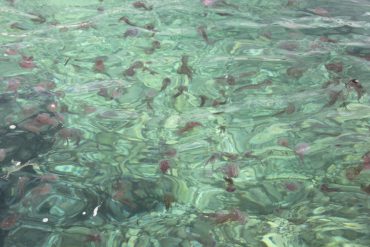 Fabien Lombard jumps in: “There is a big difference in point of views between the beach-goers and the politics. According to our sociological surveys, we realized that people don’t view jellyfish in the same way as they could view mosquitoes for example. Mosquitoes come into your home to bother you, whereas the sea is the jellyfish’s natural environment. The politics, on the other hand, clearly see it as an invasion of their municipality, which could result in the loss of valuable tourists.”
Fabien Lombard jumps in: “There is a big difference in point of views between the beach-goers and the politics. According to our sociological surveys, we realized that people don’t view jellyfish in the same way as they could view mosquitoes for example. Mosquitoes come into your home to bother you, whereas the sea is the jellyfish’s natural environment. The politics, on the other hand, clearly see it as an invasion of their municipality, which could result in the loss of valuable tourists.”
After several years of research, the scientists developed a “jellyfish weather forecast” which became quite precise depending on the location. By cross-referencing the abundance of jellyfish in the sea with local current and wind predictions, the tool could pinpoint which beach may see an arrival of stinging animals. “It’s interesting to notice that a year with an abundant population of jellyfish in the sea does not necessarily result in greater numbers of burnt victims, Fabien Lombard says. In 2013 for example, there were many more Pelagia noctiluca than the previous years, but the winds and current oscillations hardly ever brought them towards the beaches. On the contrary, in 2012, there were 10 times less jellyfish in the Ligurian current, but many more burnt bathers on the coast.” Some municipalities didn’t think a tool this precise was such a good idea, and the project was abandoned.
Luckily, mentalities have evolved and bathers are now very cautious. “Some days, says Martina Ferraris, you should simply avoid getting in the water. And people are very much aware of this now.”
############
It’s 5 am, and the Alchimie finally reaches the port of Villefranche-sur-Mer after a night-long expedition. The crew is exhausted, but the arms of Morpheus are still a few hours away. The boat needs cleaning, and the scientists need to bring back and organize all of their samples and gear in the laboratory. They are part of an international army dedicated to better understanding an animal which, according to some specialists, threatens to conquer every ocean of our planet.
Every year, the list of coastal regions that experience problems with jellyfish pullulation seems to grow longer, and many questions remain unanswered. Researchers are desperately trying to fill the gaps, but long-term reliable data is lacking. The scientific community is divided.
In 2017, it’s with the help of a sailing boat in Villefranche-sur-Mer that this precious data has been collected. The early experiences in the 1990s seem like a lifetime away. Back then, the NASA sent hundreds of jellyfish in space to measure the effect of absence of gravity on their orientation abilities.
Today, along the discoveries, these animals reveal incredible and hidden talents. We are only scratching the surface of these gelatinous species that have been swimming in our seas and oceans for the past 600 million years, surviving five great animal extinction episodes.
They seem to be invading our coasts, yet they could very well help the humanity beyond some of our wildest dreams. Jellyfish, friend or foe?
